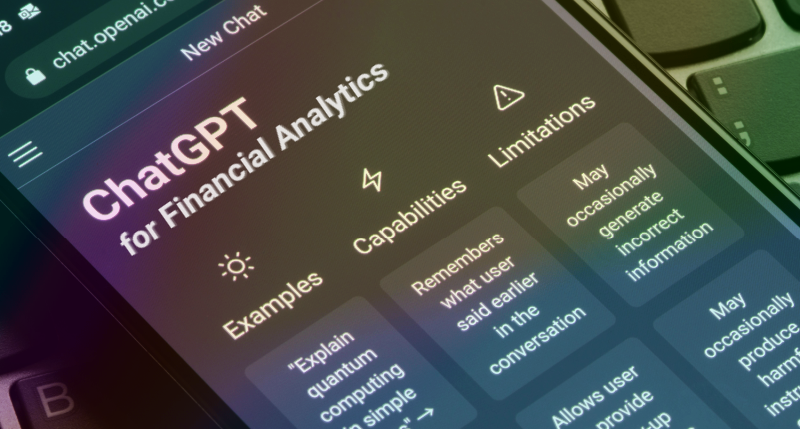In the manufacturing industry, the only way to make sound strategic decisions is through precise and efficient financial analysis. Companies need tools that will help them:
- Optimize production processes
- Manage costs
- Predict demand
- Navigate market trends
However, the best way to complete these tasks is constantly changing, which means the tools used to help need to adapt as well. This is where ChatGPT comes into play.
ChatGPT is an AI-powered language model that comprehends, generates, and responds to human language. It has the ability to help manufacturing accountants with:
- Interpreting data
- Generating insights
- Driving strategic financial decisions
In this article, we’ll cover how accountants can use ChatGPT for financial analysis and share some of our best tips for implementing it into financial analysis processes.
Understanding ChatGPT
ChatGPT’s uniqueness stands out because of its ability to bridge the gap between data and interpretation. Unlike traditional analytical tools that require an input of precise commands, ChatGPT understands natural language. This allows accountants to interact conversationally and unlock deeper insights from their data without specialized coding or technical expertise.
ChatGPT takes this one step further by not only offering reports based on metrics but also providing an explanation as to why. When used in the right context, this can be a valuable asset to accountants.
Applications of ChatGPT in Manufacturing Financial Analysis
ChatGPT can help accountants dive deeper into data interpretation and provide a better understanding of the insights they’ve been lacking. Below are a few areas it can help.
Forecasting and Budgeting
For manufacturing companies, predicting revenue and demand is critical to allocate resources and manage inventory. With the help of ChatGPT, accountants can identify intricate patterns by analyzing:
- Historical data
- Market trends
- External factors
Budgeting also plays a massive role in making decisions related to:
- Procurement
- Labor
- Production
- Distribution
When ChatGPT is used to analyze past financial data, it can provide recommendations for cost-cutting, process improvements, and resource allocation.
This is where ChatGPT stands out compared to traditional tools. Not only do you get the insights, but you get the “why” and solutions to improve.
Cost Analysis
Understanding cost structures is essential in the manufacturing industry. Because ChatGPT can process text and numerical data, it has the ability to:
- Dissect cost hierarchies
- Highlight key cost drivers
- Reveal areas to reduce manufacturing costs
Production costs and profit margins are key drivers in manufacturing financial analysis. With the help of ChatGPT, accountants can calculate productions costs for various scenarios, taking into account factors like:
- Raw material prices
- Labor costs
- Overheads
This will help with evaluating strategies and optimizing margins.
Risk Assessment
Being aware of potential risks helps accountants keep manufacturers prepared for:
- Supply chain disruptions
- Regulatory changes
- Market volatility
Incorporating ChatGPT into your financial analysis processes allows accountants to input different variables and assess the impact of events on the company’s financial health. ChatGPT will also help you devise proactive and contingency plans by analyzing:
- Historical data
- Industry reports
- External news sources
Implementing ChatGPT in Financial Analysis
Successful implementation of ChatGPT in financial analysis is promising but requires a strategic approach. Below are a few steps involved in leveraging ChatGPT.
Data Integration and Preprocessing
Before turning to ChatGPT for assistance, the data needs to be in order. Collect all of the relevant data, ensure the data is accurate and consistent, and provide contextual information for ChatGPT to leverage. This may include adding:
- Industry-specific terminology
- Product details
- Market dynamics
Interpreting and Validating Results
Use the full scope of ChatGPT’s capabilities to understand why and how it came to its conclusions. From there, you can cross-validate its answers with the insights you see from traditional analytical methods.
Integration into Decision-Making Processes
Once ChatGPT has produced insights, it’s important to leverage them with real-life experience and industry knowledge to get the best results. The combination of AI-generated insights and human brain-power is where the tool becomes the most successful.
It’s important to remember that ChatGPT is not a replacement for accountants but a tool that can make their services more valuable. When done properly, its integration into a manufacturing company’s financial analysis can:
- Streamline processes
- Identify areas for improvement
- Enhance decision-making
Is ChatGPT for Financial Analysis the Best Route?
ChatGPT has endless potential in manufacturing financial analysis. It can help accountants with accurate:
- Forecasting and budgeting
- Cost analysis
- Risk assessment
Not only does it provide efficient insights, but it also offers the “why” behind its results. This is where accountants can harness the most benefits from ChatGPT, in comparison with traditional financial analysis tools. Its responses, coupled with human expertise, can be used to make proactive, data-driven decisions.
ChatGPT sits alongside many other tools and platforms that can be used to provide manufacturing accountants with the information they need to be indispensable to their clients. With a good understanding and proper use, it can positively impact the way accountants provide financial analysis.
.png?width=150&height=63&name=TWRlogo-regmark_blueblack%20(1).png)
.png)










Do you have questions about this article? Email us and let us know > info@woodard.com
Comments: